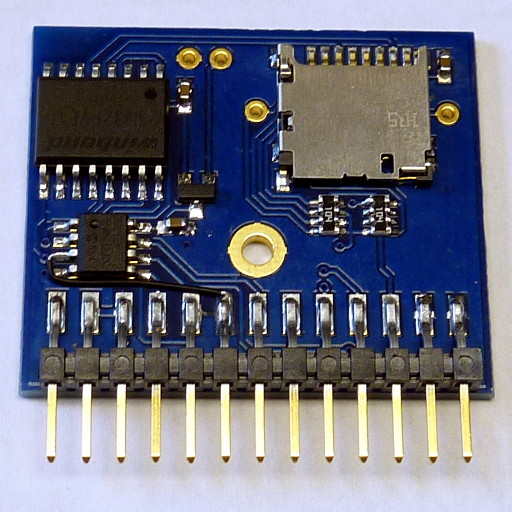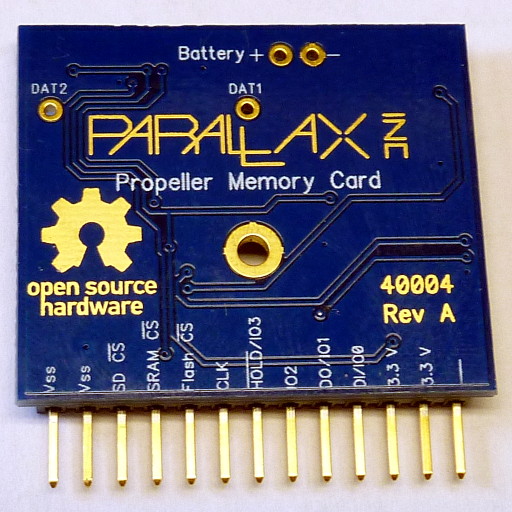I have two Propeller Memory Cards to give out. Who wants them?
 David Carrier
Posts: 294
David Carrier
Posts: 294
I have two Propeller Memory Cards to give out. They have a microSD card socket, a 25Q32FVSFIG 4M x 8 quad SPI flash device, and a 23LC1024-I/SN 128K x 8 quad SPI SRAM device. They are designed to plug into the header on a Propeller Demo Board or a Human Interface Board on a Propeller QuickStart, but they could also work in a breadboard, since they are essentially in a DIP format. I have attached the design with the schematic and layout, for those interested.
The reason that I want to give these away is that I know there are some of you who would want to use them right away, and are capable of doing so. I, on the other hand, would enjoy using them, but I won't get a whole lot out of them until I get caught up on Propeller GCC, its various memory models, and what it takes to implement them. I would also only have time to test them, then they would go into a bin of old PCBs, to wait for a spot on the "free" table at the next Propeller Expo. If I give them away, someone who could use one can get use out of it right away, and they can let me know if it is working for them. That last part is all I ask for in return. I need to know if all of the features work before I can okay it for production.
To make it official, here is what I need two volunteers to do:
David Carrier
Parallax Inc.
The reason that I want to give these away is that I know there are some of you who would want to use them right away, and are capable of doing so. I, on the other hand, would enjoy using them, but I won't get a whole lot out of them until I get caught up on Propeller GCC, its various memory models, and what it takes to implement them. I would also only have time to test them, then they would go into a bin of old PCBs, to wait for a spot on the "free" table at the next Propeller Expo. If I give them away, someone who could use one can get use out of it right away, and they can let me know if it is working for them. That last part is all I ask for in return. I need to know if all of the features work before I can okay it for production.
To make it official, here is what I need two volunteers to do:
- Use the SPI flash memory in quad SPI mode.
- Use the SPI SRAM in quad SPI mode.
- Use the microSD card. (I've already done this, but it would be good to have someone else give it a try too.)
- Send me examples of the code used, so that I can try it out too.
- Propeller Memory Card prototype.
- QuickStart and Human Interface Board, if requested.
- Satisfaction in knowing that you helped the Propeller Memory Card get to market.
David Carrier
Parallax Inc.





Comments
I would like to try running Sphinx on this. I have a version that runs on the C3 and has provisions for a file system on flash memory in addition to the SD card system. I also have some programs that use the C3's SRAM for working storage and could try adapting those. It would also be simple to get FemtoBasic to run on this combo (QuickStart, HIB, and Memory Card). I have a version for the C3 that allows access to the flash and SRAM that could easily be modified.
Mike
David Betz, don't we need a sample of this hardware to make sure it works with Propeller-GCC?
I suppose a Parallax person could test it ....
I sent one to David Betz, so he can make it work with Propeller GCC. I also like Mike Green's Idea of running Sphinx and FemtoBasic on it. That will build up some examples in Spine, too.
JasonDorie and doggiedoc,
If I sent you each a board, could you get it working right away, or would you need examples from David Betz or Mike Green? Would either of you be comfortable with the a kit that requires surface mount assembly? I built one in less than an hour, with a fine point soldering iron, a roll of thin solder, and a pair of tweezers.The hardest part is the resistors for the microSD card and the jumper wire. You can build it without the microSD card, and you can use it in single or dual SPI mode (but not quad) without the jumper.
How about this: David Betz and Mike Green get the first two boards. Once either one of them posts a quad-spi example that uses the flash and one that uses the SRAM, (or one example that uses both) then I will take pictures of the unmodified board, modify it and verify the posted examples, get the next revision on order, and ship the two boards out to JasonDorie and doggiedoc. If either JasonDorie or doggiedoc could use a board right away, I could ship them the modified one now, then, after the next revision is on order, modify and ship the one I am saving for pictures. If they both want them now, I can send one an assembled and modified one, and the other a kit.
Does this work for everyone?
Thank you,
David Carrier
Parallax Inc.
If not, maybe next time.
Thanks,
jt
David Betz,
You should be okay with the board you have, I'll just need to test everything out on the latest modified board, with a microSD card inserted, to make sure the card behaves as it should when its select line is not asserted. If you can send me the the programs you are using to test the SRAM and Flash memories in quad SPI mode, I can test them on the board I've modified.
Everyone else,
I can send out the boards as discussed earlier, as soon as I've verified the modified one. I'll send a kit to doggiedoc, and assembled boards to Mike Green, JasonDorie, and jtilghman. Send me a private message or email with your shipping address, and I'll get them out as soon as I can.
David Carrier
Parallax Inc.
carrier.zip
@David Betz - How's the software for it coming along on your end?
Paul
Thanks David!
Attached is a corrected Memory Card Basic. I had left out the statements for low level access to Flash and SRAM. SRAM[<expr>{,<expr>}]] and FLASH[<expr>{,<expr>}] are both allowed as expressions and "pseudo-variables" on the left side of "=". The first <expr> is the address in SRAM or Flash. The second <expr> is the number of bytes (1 to 4) with a default of 1. Bytes are little-endian. There's also ERASE <expr> which erases the Flash sector containing the provided address.
NB: Doesn't work yet ... check back tomorrow
Attached is the latest version. SRAM[<expr>{,<expr>}] and SRAM[<expr>{,<expr>}]=<expr> both work and there's a simple memory test included (memtest.bas) in the archive. Next stop ... checking the low-level Flash I/O. Note that I'm currently using the Spin-only driver.